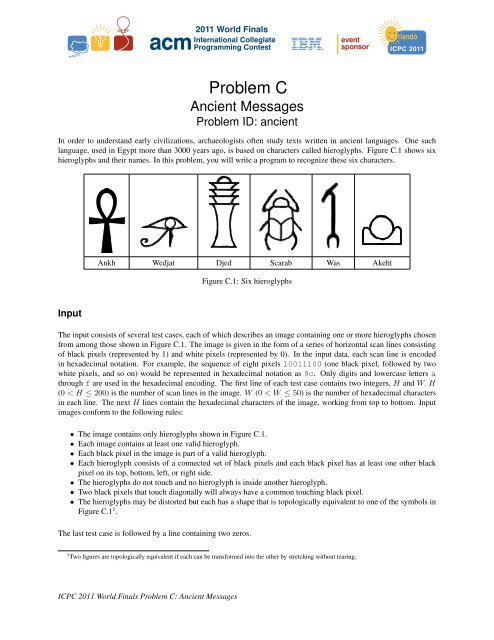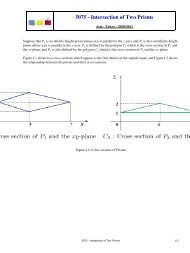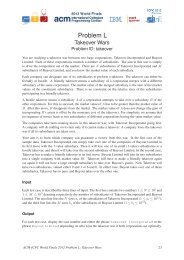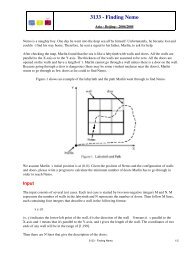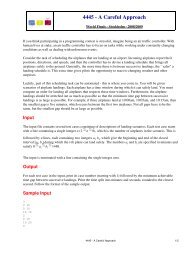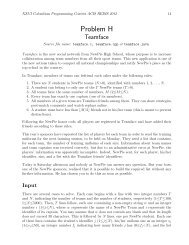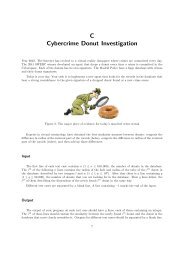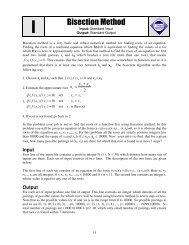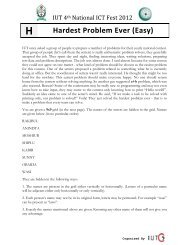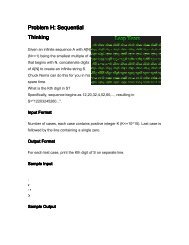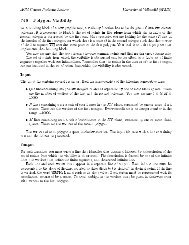Problem C - UVa Online Judge
Problem C - UVa Online Judge
Problem C - UVa Online Judge
- No tags were found...
Create successful ePaper yourself
Turn your PDF publications into a flip-book with our unique Google optimized e-Paper software.
<strong>Problem</strong> CAncient Messages<strong>Problem</strong> ID: ancientIn order to understand early civilizations, archaeologists often study texts written in ancient languages. One suchlanguage, used in Egypt more than 3000 years ago, is based on characters called hieroglyphs. Figure C.1 shows sixhieroglyphs and their names. In this problem, you will write a program to recognize these six characters.Ankh Wedjat Djed Scarab Was AkehtFigure C.1: Six hieroglyphsInputThe input consists of several test cases, each of which describes an image containing one or more hieroglyphs chosenfrom among those shown in Figure C.1. The image is given in the form of a series of horizontal scan lines consistingof black pixels (represented by 1) and white pixels (represented by 0). In the input data, each scan line is encodedin hexadecimal notation. For example, the sequence of eight pixels 10011100 (one black pixel, followed by twowhite pixels, and so on) would be represented in hexadecimal notation as 9c. Only digits and lowercase letters athrough f are used in the hexadecimal encoding. The first line of each test case contains two integers, H and W. H(0 < H ≤ 200) is the number of scan lines in the image. W (0 < W ≤ 50) is the number of hexadecimal charactersin each line. The next H lines contain the hexadecimal characters of the image, working from top to bottom. Inputimages conform to the following rules:• The image contains only hieroglyphs shown in Figure C.1.• Each image contains at least one valid hieroglyph.• Each black pixel in the image is part of a valid hieroglyph.• Each hieroglyph consists of a connected set of black pixels and each black pixel has at least one other blackpixel on its top, bottom, left, or right side.• The hieroglyphs do not touch and no hieroglyph is inside another hieroglyph.• Two black pixels that touch diagonally will always have a common touching black pixel.• The hieroglyphs may be distorted but each has a shape that is topologically equivalent to one of the symbols inFigure C.1 1 .The last test case is followed by a line containing two zeros.1 Two figures are topologically equivalent if each can be transformed into the other by stretching without tearing.ICPC 2011 World Finals <strong>Problem</strong> C: Ancient Messages
OutputFor each test case, display its case number followed by a string containing one character for each hieroglyph recognizedin the image, using the following code:Ankh: AWedjat: JDjed: DScarab: SWas: WAkhet: KIn each output string, print the codes in alphabetic order. Follow the format of the sample output.The sample input contains descriptions of test cases shown in Figures C.2 and C.3. Due to space constraints not all ofthe sample input can be shown on this page.Figure C.2: AKWFigure C.3: AAAAASample input100 2500000000000000000000000000000000000000000000000000...(50 lines omitted)...00001fe0000000000007c000000003fe0000000000007c0000...(44 lines omitted)...00000000000000000000000000000000000000000000000000150 380000000000000000000000000000000000000000000000000000000000000000000000000000...(75 lines omitted)...0000000003fffffffffffffffff000000000000000000003fffffffffffffffff00000000000...(69 lines omitted)...00000000000000000000000000000000000000000000000000000000000000000000000000000 0Output for the Sample InputCase 1: AKWCase 2: AAAAAICPC 2011 World Finals <strong>Problem</strong> C: Ancient Messages


